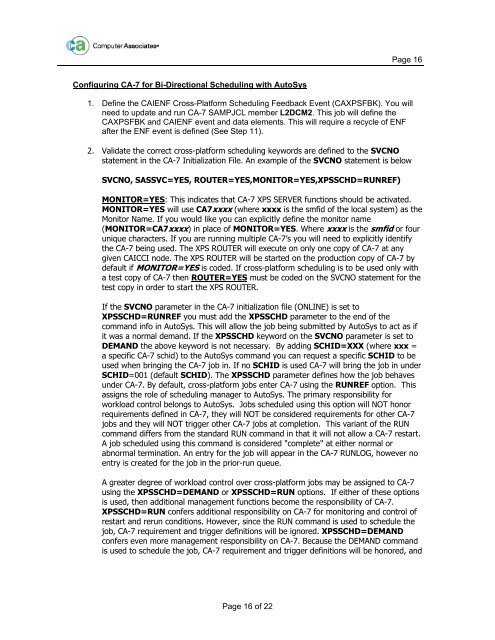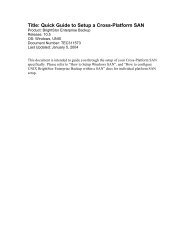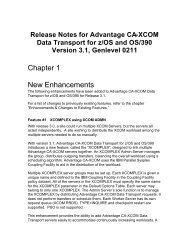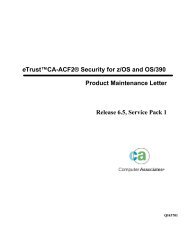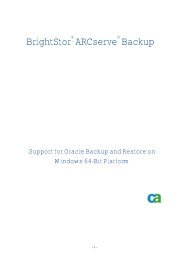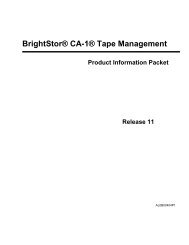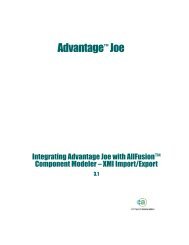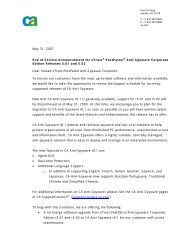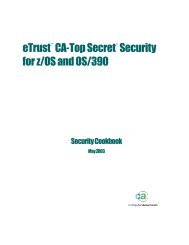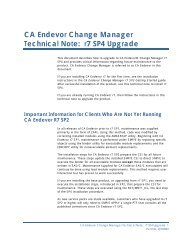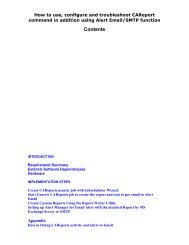Configuring AutoSys and CA-7 for Cross-Platform ... - SupportConnect
Configuring AutoSys and CA-7 for Cross-Platform ... - SupportConnect
Configuring AutoSys and CA-7 for Cross-Platform ... - SupportConnect
Create successful ePaper yourself
Turn your PDF publications into a flip-book with our unique Google optimized e-Paper software.
Page 16<strong>Configuring</strong> <strong>CA</strong>-7 <strong>for</strong> Bi-Directional Scheduling with <strong>AutoSys</strong>1. Define the <strong>CA</strong>IENF <strong>Cross</strong>-Plat<strong>for</strong>m Scheduling Feedback Event (<strong>CA</strong>XPSFBK). You willneed to update <strong>and</strong> run <strong>CA</strong>-7 SAMPJCL member L2DCM2. This job will define the<strong>CA</strong>XPSFBK <strong>and</strong> <strong>CA</strong>IENF event <strong>and</strong> data elements. This will require a recycle of ENFafter the ENF event is defined (See Step 11).2. Validate the correct cross-plat<strong>for</strong>m scheduling keywords are defined to the SVCNOstatement in the <strong>CA</strong>-7 Initialization File. An example of the SVCNO statement is belowSVCNO, SASSVC=YES, ROUTER=YES,MONITOR=YES,XPSSCHD=RUNREF)MONITOR=YES: This indicates that <strong>CA</strong>-7 XPS SERVER functions should be activated.MONITOR=YES will use <strong>CA</strong>7xxxx (where xxxx is the smfid of the local system) as theMonitor Name. If you would like you can explicitly define the monitor name(MONITOR=<strong>CA</strong>7xxxx) in place of MONITOR=YES. Where xxxx is the smfid or fourunique characters. If you are running multiple <strong>CA</strong>-7’s you will need to explicitly identifythe <strong>CA</strong>-7 being used. The XPS ROUTER will execute on only one copy of <strong>CA</strong>-7 at anygiven <strong>CA</strong>ICCI node. The XPS ROUTER will be started on the production copy of <strong>CA</strong>-7 bydefault if MONITOR=YES is coded. If cross-plat<strong>for</strong>m scheduling is to be used only witha test copy of <strong>CA</strong>-7 then ROUTER=YES must be coded on the SVCNO statement <strong>for</strong> thetest copy in order to start the XPS ROUTER.If the SVCNO parameter in the <strong>CA</strong>-7 initialization file (ONLINE) is set toXPSSCHD=RUNREF you must add the XPSSCHD parameter to the end of thecomm<strong>and</strong> info in <strong>AutoSys</strong>. This will allow the job being submitted by <strong>AutoSys</strong> to act as ifit was a normal dem<strong>and</strong>. If the XPSSCHD keyword on the SVCNO parameter is set toDEMAND the above keyword is not necessary. By adding SCHID=XXX (where xxx =a specific <strong>CA</strong>-7 schid) to the <strong>AutoSys</strong> comm<strong>and</strong> you can request a specific SCHID to beused when bringing the <strong>CA</strong>-7 job in. If no SCHID is used <strong>CA</strong>-7 will bring the job in underSCHID=001 (default SCHID). The XPSSCHD parameter defines how the job behavesunder <strong>CA</strong>-7. By default, cross-plat<strong>for</strong>m jobs enter <strong>CA</strong>-7 using the RUNREF option. Thisassigns the role of scheduling manager to <strong>AutoSys</strong>. The primary responsibility <strong>for</strong>workload control belongs to <strong>AutoSys</strong>. Jobs scheduled using this option will NOT honorrequirements defined in <strong>CA</strong>-7, they will NOT be considered requirements <strong>for</strong> other <strong>CA</strong>-7jobs <strong>and</strong> they will NOT trigger other <strong>CA</strong>-7 jobs at completion. This variant of the RUNcomm<strong>and</strong> differs from the st<strong>and</strong>ard RUN comm<strong>and</strong> in that it will not allow a <strong>CA</strong>-7 restart.A job scheduled using this comm<strong>and</strong> is considered "complete" at either normal orabnormal termination. An entry <strong>for</strong> the job will appear in the <strong>CA</strong>-7 RUNLOG, however noentry is created <strong>for</strong> the job in the prior-run queue.A greater degree of workload control over cross-plat<strong>for</strong>m jobs may be assigned to <strong>CA</strong>-7using the XPSSCHD=DEMAND or XPSSCHD=RUN options. If either of these optionsis used, then additional management functions become the responsibility of <strong>CA</strong>-7.XPSSCHD=RUN confers additional responsibility on <strong>CA</strong>-7 <strong>for</strong> monitoring <strong>and</strong> control ofrestart <strong>and</strong> rerun conditions. However, since the RUN comm<strong>and</strong> is used to schedule thejob, <strong>CA</strong>-7 requirement <strong>and</strong> trigger definitions will be ignored. XPSSCHD=DEMANDconfers even more management responsibility on <strong>CA</strong>-7. Because the DEMAND comm<strong>and</strong>is used to schedule the job, <strong>CA</strong>-7 requirement <strong>and</strong> trigger definitions will be honored, <strong>and</strong>Page 16 of 22


